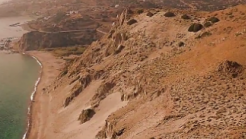

Greece
The city of Heraklion in the Middle Ages it was known as the "Castle". Rightly named so because of that time was surrounded by walls. Remains of this wall are located scattered within the city.
The city of Heraklion in the Middle Ages it was known as the "Castle". Rightly named so because of that time was surrounded by walls. Remains of this wall are located scattered within the city.
The short conquest by the Arabs brought changes in fortification, which was built in the stone base and surrounded by a deep moat. The ditch that we can wander it, was starting from Liberty Stadium in the Michael Koraka Square. Pieces of the Arab wall are still visible in underground basements of shops in the city center.
After the reconquest of the Byzantines in 961, Nikiforos Fokas built a fort in the village of Prophet Elias, which was named "Temenos", just outside of Candia. A large part of this fort still survives today. Harbor was better organized and fortifications were strengthened. Headquarters of the current byzantine administration was in Eleftherios Venizelos Square. The city developed between the streets Daedalus, Chandakos Epimenidou and Beaufort. Specifically, the route Diadalou, which runs through the center of Heraklion, runs parallel to the medieval wall. In this street was the southern boundary of the city and beyond it there were no houses. To become in a more perceptible way, imagine that you are in the 9th century and walk up the street from east to west. On your right hand you would have the city and the wall on your left and you would see orchards and other cultivated fields that were providing to residents the necessary food.
As foretold, by the Byzantine architectural or Arab one is not preserved almost nothing, since they suffered many disasters and changes over time. For the more curious visitors but who wants to come in contact with this unknown aspect of history that is sure to amaze you, some pieces of medieval wall is literally hidden in shops or in buildings. These are accessible only with the help of a qualified archaeologist who will be able to provide you with historical and archaeological information.
When Crete was conquered by the Venetians, the Arab-Byzantine wall no longer had any significance, as the city grew and the need has arisen for the creation of more efficient fortifications.


Southern Crete After the beach of Saint Pavlos a path leads tot he beach of dunes.


The visitor becomes acquainted with the arts of ancient Chios, understands the history and topography of the island, and realizes the island’s importance during the ancient times.


Τhe report of the Archaeological Museum Rethymno include items from various excavations and give a timeless image of cultural history of the country from the Neolithic period to the years of Roman occupancy.
1039 Ε 6061 01515 00